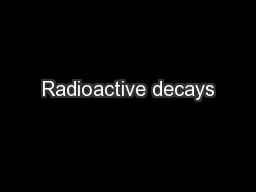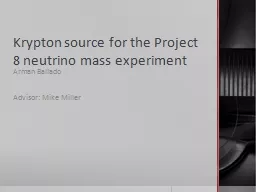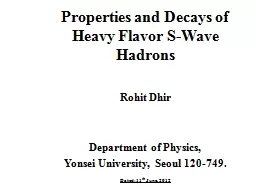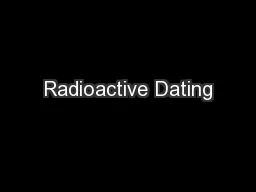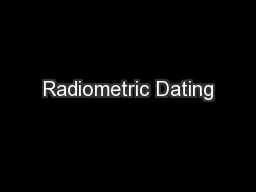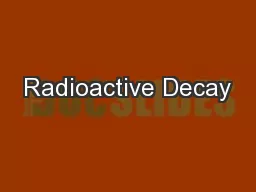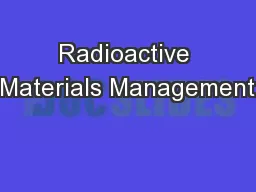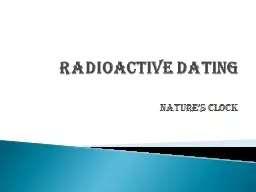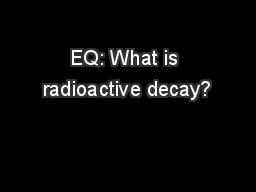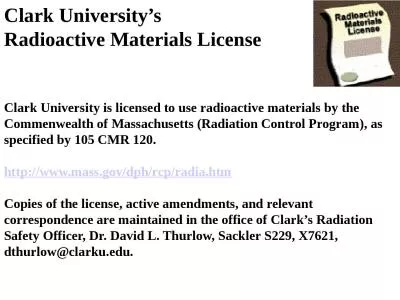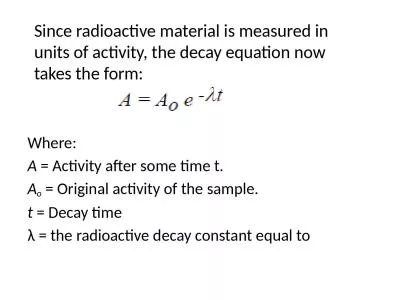PDF-Radioactive decays
Author : tawny-fly | Published Date : 2016-03-11
A simplified model of the nucleus Coulomb Barrier for the charged particlesprotonsneutronsSquare well potential approx Filled levels
Presentation Embed Code
Download Presentation
Download Presentation The PPT/PDF document "Radioactive decays" is the property of its rightful owner. Permission is granted to download and print the materials on this website for personal, non-commercial use only, and to display it on your personal computer provided you do not modify the materials and that you retain all copyright notices contained in the materials. By downloading content from our website, you accept the terms of this agreement.
Radioactive decays: Transcript
A simplified model of the nucleus Coulomb Barrier for the charged particlesprotonsneutronsSquare well potential approx Filled levels. Fourth lecture. Discovery of radio activity. Radioactivity was the first nuclear phenomenon to be discovered , the credit for this discovery goes to the French physicist Henri Becquerel (1896) .. Radioactivity . Arman Ballado. Advisor: Mike Miller. Neutrino mass measurement. Beta Decay . . Griffiths. Tritium Beta Decay . Endpoint energy of 18.575 . keV. J.A. . Formaggio. . Project 8 Concept. Use cyclotron frequency to measure energy . Q1b. What is the physical state of this layer?. Q2. What is the scientific name for the layer of the earth between 670 and 40 km?. Q3. What drives the movement of tectonic plates?. Q4. What type of boundary is there between the Pacific plate and Australian plate?. Rohit. . Dhir. Department of Physics, . Yonsei. University, Seoul 120-749.. Dated:11. th. June, 2012. Matter & Forces. Matter. Leptons. Charged. Neutrinos. Forces. Weak. EM. Strong. Gravity. Hadrons. What is Radioactive Decay?. What is Radioactive Dating?. How do Scientists Determine Earth’s Age?. 93.75%. 6.25%. What is Radioactive Dating?. . DE 1:24 . 1. 3.9 billion years. 2. 22, 920 years. A. Hawkins. K. . Langhoff. J. . Shevlin. Jacksonville High School. As You Come In…. How old would you say this object is? Explain in a couple of sentences your reasoning for selecting the age that you did.. Why are some elements (isotopes) more stable than others?. The Nucleus. The Electric Force. Protons hate Protons. Strong Force. Strong Force Facts. Neutrons act like cement. Strong Force is very strong over a small distance (about the distance of two protons). NUCP2311. Low Level and High Waste Treatment Options. Low level . diluted . dispersed. If short T. 1/2 . can let decay. High level. Usually concentrated . Needs to be contained. Isolate from environment. Quarknet. workshop at OU. Outline. Stable and unstable particles. How to observe them?. How to find their mass?. How to calculate their lifetime?. 6/9/2010. 2. What is a particle?. Matter around us consists of a few types of particles (both fundamental and just subatomic particles that have some structure): . When sedimentary rock is deposited in layers it is deposited horizontally.. Scientists use this “Principle of Original Horizontality” to help them determine the age of the layers.. The older layers of rock are found below the younger layers of rock.. Unscramble the following keywords for today’s lesson:. . Yecad. Iriaovadect. Ootspei. Nsteruon. nadgit. Isotopes . When the nucleus of an atom possesses either too many or too few neutrons compared to the number of protons it becomes unstable. These are called radioactive isotopes. Unstable nuclei split up in a process called radioactive decay and emit radioactive radiation.. Ray KoweNovember, London, United KingdomPage EF 6 Implementing Geological Disposal of Radioactive Waste Technology Platform IGDExchange ForumIGDTP Working Group on RD&D DisseminationRay Kowe, RWMGunna Commenwealth. of Massachusetts (Radiation Control Program), as specified by 105 CMR 120. . http://www.mass.gov/dph/rcp/radia.htm. . Copies of the license, active amendments, and relevant correspondence are maintained in the office of Clark’s Radiation Safety Officer, Dr. David L. Thurlow, . Where: . A . = Activity after some time t.. A. o. . = Original activity of the sample.. t . = Decay time . λ = the radioactive decay constant equal to . The half-life equation can be also used for activity, simply by replacing the number of atoms .
Download Document
Here is the link to download the presentation.
"Radioactive decays"The content belongs to its owner. You may download and print it for personal use, without modification, and keep all copyright notices. By downloading, you agree to these terms.
Related Documents

